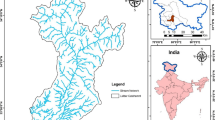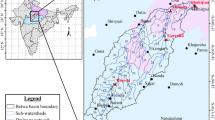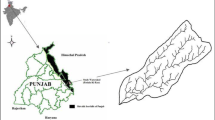Abstract
Assessment of climate and land use changes impact including extreme events on the sediment yield is vital for water and power stressed countries. Mangla Reservoir is the second-largest reservoir in Pakistan, and its capacity is being reduced due to rapid sedimentation and will be threatened under climate and land use changes. This paper discusses the consequences of climate and land use change on sediment yield at Mangla Dam using General Circulation Models (GCMs), Land Change Modeler (LCM), Soil and Water Assessment Tool (SWAT) model after calibration and validation. Results show that over the historical period temperature is observed to increase by 0.10oC/decade and forest cover is observed to reduce to the level of only 16% in 2007. Nevertheless, owing to the forest conservation policy, the forest cover raised back to 27% in 2012. Anticipated land use maps by using LCM of 2025, 2050 and 2100 showed that the forest cover will be 33%, 39.2%, and, 53.7%, respectively. All seven GCMs projected the increase in temperature and five GCMs projected an increase in precipitation, however, two GCMs projected a decrease in precipitation. Owing to climate change, land use change and combined impact of climate and land use change on annual sediment yield (2011-2100) may vary from -42.9% to 39.4%, 0% to -27.3% and, -73% to 39.4%, respectively. Under climate change scenarios projected sediment yield is mainly linked with extreme events and is expected to increase with the increase in extreme events. Under land use change scenarios projected sediment yield is mainly linked with the forest cover and is expected to decrease with the increase in forest cover. The results of this study are beneficial for planners, watershed managers and policymakers to mitigate the impacts of climate and land use changes to enhance reservoir life by reducing the sediment yield.
Similar content being viewed by others
References
Ahmad Z, Hafeez M, Ahmad I (2012) Hydrology of mountainous areas in the upper Indus Basin, Northern Pakistan with the perspective of climate change. Environmental Monitoring and Assessment 184(9): 5255–5274. https://doi.org/10.1007/s10661-011-2337-7
Ahmed B, Ahmed R (2012) Modeling Urban Land Cover Growth Dynamics Using Multi-Temporal Satellite Images: A Case Study of Dhaka, Bangladesh. ISPRS International Journal of Geo-Information 1(1): 3–31.
Alava JJ, Cisneros-Montemayor AM, Sumaila UR, et al. (2018) Projected amplification of food web bioaccumulation of MeHg and PCBs under climate change in the Northeastern Pacific. Scientific Reports 8. https://doi.org/10.1038/S41598-018-31824-5
Alley R, Berntsen T, Bindoff NL, et al. (2007) Climate change 2007: The physical science basis. Contribution of Working Group I to the Fourth Assessment Report of the Intergovernmental Panel on Climate Change. Summary for Policymakers. IPCC Secretariat, Geneva, Switzerland. p.21.
Andriuzzi WS, Adams BJ, Barrett JE, et al. (2018) Observed trends of soil fauna in the Antarctic Dry Valleys: early signs of shifts predicted under climate change. Ecology 99(2): 312–321. https://doi.org/10.1002/ecy.2090
Aronica GT, Bonaccorso B (2013) Climate Change Effects on Hydropower Potential in the Alcantara River Basin in Sicily (Italy). Earth Interactions 17. https://doi.org/10.1175/2012ei000508.1
Astakhov AS, Vologina EG, Dar'in AV, et al. (2018) Influence of Global Climate Changes in Past Centuries on the Chemical Composition of Bottom Sediments in the Chukchi Sea. Russian Meteorology and Hydrology 43(4): 251–257. https://doi.org/10.3103/S1068373918040064
Azmat M, Choi M, Kim TW, et al. (2016) Hydrological modeling to simulate streamflow under changing climate in a scarcely gauged cryosphere catchment. Environmental Earth Sciences 75(3). https://doi.org/10.1007/S12665-015-5059-2
Azmat M, Liaqat UW, Qamar MU, et al. (2017) Impacts of changing climate and snow cover on the flow regime of Jhelum River, Western Himalayas. Regional Environmental Change 17(3): 813–825. https://doi.org/10.1007/s10113-016-1072-6
Babel MS, BhusalSP, Wahid SM, et al. (2014) Climate change and water resources in the Bagmati River Basin, Nepal. Theoretical and Applied Climatology 115(3-4): 639–654. https://doi.org/10.1007/s00704-013-0910-4
Babur M, Babel M, Shrestha S, et al. (2016) Assessment of Climate Change Impact on Reservoir Inflows Using Multi Climate-Models under RCPs—The Case of Mangla Dam in Pakistan. Water 8(9): 389.
Bieger K, Hormann G, Fohrer N (2014) Simulation of Streamflow and Sediment with the Soil and Water Assessment Tool in a Data Scarce Catchment in the Three Gorges Region, China. Journal of Environmental Quality 43(1): 37–45. https://doi.org/10.2134/jeq2011.0383
Blainski E, Porras EAA, Garbossa LHP, et al. (2017) Simulation of land use scenarios in the Camboriu River Basin using the SWAT model. Rbrh-Revista Brasileira De Recursos Hidricos 22.
Boongaling CGK, Faustino-Eslava DV, Lansigan FP (2018) Modeling land use change impacts on hydrology and the use of landscape metrics as tools for watershed management: The case of an ungauged catchment in the Philippines. Land Use Policy 72: 116–128. https://doi.org/10.1016/j.landusepol.2017.12.042
Bossa AY, Diekkruger B, Agbossou EK (2014) Scenario-Based Impacts of Land Use and Climate Change on Land and Water Degradation from the Meso to Regional Scale. Water 6(10): 3152–3181. https://doi.org/10.3390/w6103152
Bressiani DD, Gassman PW, Fernandes JG, et al. (2015) Review of Soil and Water Assessment Tool (SWAT) applications in Brazil: Challenges and prospects. International Journal of Agricultural and Biological Engineering 8(3): 9–35. https://doi.org/10.3965/j.ijabe.20150803.1765
Bruggeman D, Meyfroidt P, Lambin EF (2018) Impact of land-use zoning for forest protection and production on forest cover changes in Bhutan. Applied Geography 96: 153–165. https://doi.org/10.1016/j.apgeog.2018.04.011
Butt MJ, Mahmood R, Waqas A (2011) Sediments deposition due to soil erosion in the watershed region of Mangla Dam. Environmental Monitoring and Assessment 181(1-4): 419–429.
Butt MJ, Waqas A, Mahmood R, et al. (2010) The Combined Effect of Vegetation and Soil Erosion in the Water Resource Management. Water Resources Management 24(13): 3701–3714.
Castilla G, Guthrie RH, Hay GJ (2009) The Land-cover Change Mapper (LCM) and its Application to Timber Harvest Monitoring in Western Canada. Photogrammetric Engineering and Remote Sensing 75(8): 941–950.
Chen DS, Li J, Zhou ZX, et al. (2018) Simulating and mapping the spatial and seasonal effects of future climate and land -use changes on ecosystem services in the Yanhe watershed, China. Environmental Science and Pollution Research 25(2): 1115–1131. https://doi.org/10.1007/s11356-017-0499-8
Costa S, Picado A, Vaz N, et al. (2018) Climate Change Effects on Suspended Sediment Dynamics in a Coastal Lagoon: Ria de Aveiro (Portugal). Journal of Coastal Research 521–525. doi: 10.2112/SI85-105.1
Costanza R, Ruth M (1998) Using dynamic modeling to scope environmental problems and build consensus. Environmental Management 22(2): 183–195.
da Silva VDR, Silva MT, Singh VP, et al. (2018) Simulation of stream flow and hydrological response to land-cover changes in a tropical river basin. Catena 162: 166–176. https://doi.org/10.1016/j.catena.2017.11.024
de Aragao R, Cruz MAS, de Amorim JRA, et al. (2013) Sensitivity Analysis of the Parameters of the Swat Model and Simulation of the Hydrosedimentological Processes in a Watershed in the Northeastern Region of Brazil. Revista Brasileira De Ciencia Do Solo 37(4): 1091–1102. https://doi.org/10.1590/S0100-06832013000400026
Deb D, Butcher J, Srinivasan R (2015) Projected Hydrologic Changes Under Mid-21st Century Climatic Conditions in a Sub-arctic Watershed. Water Resources Management 29(5): 1467–1487.
Eastman JR (2009) IDRISI Taiga guide to GIS and image processing. Clark Labs, Clark University, Worcester.
Eckstein D, Künzel V, Schäfer L (2017) Global climate risk index 2018. Germanwatch, Bonn.
El Ouahabi M, Hubert-Ferrari A, Lebeau H, et al. (2018) Soil erosion in relation to land-use changes in the sediments of Amik Lake near Antioch antique city during the last 4 kyr. Holocene 28(1): 104–118. https://doi.org/10.1177/0959683617715702
Fang GH, Yang J, Chen YN, et al. (2015) Comparing bias correction methods in downscaling meteorological variables for a hydrologic impact study in an arid area in China. Hydrology and Earth System Sciences 19(6): 2547–2559. https://doi.org/10.5194/hess-19-2547-2015
Guo JH, Huang GH, Wang XQ, et al. (2018) Future changes in precipitation extremes over China projected by a regional climate model ensemble. Atmospheric Environment 188: 142–156. https://doi.org/10.1016/j.atmosenv.2018.06.026
Gyamfi C, Ndambuki JM, Salim RW (2016) Simulation of Sediment Yield in a Semi-Arid River Basin under Changing Land Use: An Integrated Approach of Hydrologic Modelling and Principal Component Analysis. Sustainability 8(11).
Haguma D, Leconte R, Cote P, et al. (2014) Optimal Hydropower Generation Under Climate Change Conditions for a Northern Water Resources System. Water Resources Management 28(13): 4631–4644. https://doi.org/10.1007/s11269-014-0763-3
Hormann G, Koplin N, Cai Q, et al. (2009) Using a simple model as a tool to parameterise the SWAT model of the Xiangxi river in China. Quaternary International 208: 116–120. https://doi.org/10.1016/j.quaint.2008.11.007
Hovenga PA, Wang DB, Medeiros SC, et al. (2016) The response of runoff and sediment loading in the Apalachicola River, Florida to climate and land use land cover change. Earths Future 4(5): 124–142. https://doi.org/10.1002/2015EF000348
Hu YR, Maskey S, Uhlenbrook S (2013) Downscaling daily precipitation over the Yellow River source region in China: a comparison of three statistical downscaling methods. Theoretical and Applied Climatology 112(3-4): 447–460. https://doi.org/10.1007/s00704-012-0745-4
IPCC (2001) The Scientific Basis. Cambridge, United Kingdom and New York, NY: USA: Cambridge University Press.
Joshi PK, Yadav K, Sinha VSP (2011) Assessing impact of forest landscape dynamics on migratory corridors: a case study of two protected areas in Himalayan foothills. Biodiversity and Conservation 20(14): 3393–3411.
Kasetkasem T, Rakwatin P, Sirisommai R, et al. (2013) A Joint Land Cover Mapping and Image Registration Algorithm Based on a Markov Random Field Model. Remote Sensing 5(10): 5089–5121.
Khan MAA (2015) Green Growth Initiative of Khyber Pakhtunkhwa Province, Pakistan. The International Journal on Green Growth and Development 1: 125–132.
Khoi DN, Suetsugi T (2014) The responses of hydrological processes and sediment yield to land-use and climate change in the Be River Catchment, Vietnam. Hydrological Processes 28(3): 640–652. https://doi.org/10.1002/hyp.9620
Krause P, Boyle D, Bäse F (2005) Comparison of different efficiency criteria for hydrological model assessment. Advances in Geosciences 5: 89–97.
Li TH, Gao Y (2015) Runoff and sediment yield variations in response to precipitation changes: A case study of Xichuan watershed in the Loess Plateau, China. Water 7(10): 5638–5656. https://doi.org/10.3390/w7105638
Ligaray M, Kim H, Sthiannopkao S, et al. (2015) Assessment on Hydrologic response by climate change in the Chao Phraya River Basin, Thailand. Water 7(12): 6892–6909.
Mahmood R, Babel MS, Jia SF (2015) Assessment of temporal and spatial changes of future climate in the Jhelum river basin, Pakistan and India. Weather and Climate Extremes 10: 40–55. https://doi.org/10.1016/j.wace.2015.07.002
Mahmood R, Jia SF (2016) Assessment of impacts of climate change on the water resources of the transboundary Jhelum River Basin of Pakistan and India. Water 8(6). https://doi.org/246 10.3390/W8060246
Mehdi B, Lehner B, Gombault C, et al. (2015) Simulated impacts of climate change and agricultural land use change on surface water quality with and without adaptation management strategies. Agriculture Ecosystems & Environment 213: 47–60. https://doi.org/10.1016/j.agee.2015.07.019
Mushtaq F, Pandey AC (2014) Assessment of land use/land cover dynamics vis-a-vis hydrometeorological variability in Wular Lake environs Kashmir Valley, India using multitemporal satellite data. Arabian Journal of Geosciences 7(11): 4707–4715. https://doi.org/10.1007/s12517-013-1092-1
Nicholls RJ, Marinova N, Lowe JA, Brown S, Vellinga P, De Gusmao D,... Tol RSJ (2011) Sea-level rise and its possible impacts given a ‘beyond 4 degrees C world’ in the twenty-first century. Philosophical Transactions of the Royal Society a-Mathematical Physical and Engineering Sciences 369(1934): 161–181. https://doi.org/10.1098/rsta.2010.0291
O'Neal MR, Nearing MA, Vining RC, Southworth J, Pfeifer RA (2005) Climate change impacts on soil erosion in Midwest United States with changes in crop management. Catena 61(2-3): 165–184. https://doi.org/10.1016/j.catena.2005.03.003
Onate-Valdivieso F, Sendra JB (2010) Application of GIS and remote sensing techniques in generation of land use scenarios for hydrological modeling. Journal of Hydrology 395(3-4): 256–263.
Op de Hipt F, Diekkruger B, Steup G, Yira Y, Hoffmann T, Rode M (2018) Modeling the impact of climate change on water resources and soil erosion in a tropical catchment in Burkina Faso, West Africa. Catena 163: 63–77. https://doi.org/10.1016/j.catena.2017.11.023
Park JY, Kim SJ (2014) Potential Impacts of Climate Change on the Reliability of Water and Hydropower Supply from a Multipurpose Dam in South Korea. Journal of the American Water Resources Association 50(5): 1273–1288. https://doi.org/10.1111/Jawr.12190
Rahman K, Maringanti C, Beniston M, Widmer F, Abbaspour K, Lehmann A (2013) Streamflow Modeling in a Highly Managed Mountainous Glacier Watershed Using SWAT: The Upper Rhone River Watershed Case in Switzerland. Water Resources Management 27(2): 323–339. https://doi.org/10.1007/s11269-012-0188-9
Rajaei F, Sari AE, Salmanmahiny A, Randhir TO, Delavar M, Behrooz RD, Bavani AM (2018) Simulating long-term effect of Hyrcanian forest loss on phosphorus loading at the sub-watershed level. Journal of Arid Land 10(3): 457–469. https://doi.org/10.1007/s40333-018-0012-3
Ramos MC, Jones GV, Yuste J (2018) Phenology of Tempranillo and Cabernet-Sauvignon varieties cultivated in the Ribera del Duero DO: observed variability and predictions under climate change scenarios. Oeno One 52(1): 31–44. https://doi.org/10.20870/oeno-one.2018.52.1.2119
Rashid I, Romshoo SA (2013) Impact of anthropogenic activities on water quality of Lidder River in Kashmir Himalayas. Environmental Monitoring and Assessment 185(6): 4705–4719. https://doi.org/10.1007/s10661-012-2898-0
Rather MI, Rashid I, Shahi N, et al. (2016) Massive land system changes impact water quality of the Jhelum River in Kashmir Himalaya. Environmental Monitoring and Assessment 188(3). https://doi.org/10.1007/S10661-016-5190-X
Ricci GF, De Girolamo AM, Abdelwahab OM, et al. (2018) Identifying sediment source areas in a Mediterranean watershed using the SWAT model. Land Degradation & Development 29(4): 1233–1248.
Saha PP, Zeleke K, Hafeez M (2014) Streamflow modeling in a fluctuant climate using SWAT: Yass River catchment in south eastern Australia. Environmental Earth Sciences 71(12): 5241–5254.
San Jose R, Perez JL, Gonzalez RM, et al. (2016) Impacts of the 4.5 and 8.5 RCP global climate scenarios on urban meteorology and air quality: Application to Madrid, Antwerp, Milan, Helsinki and London. Journal of Computational and Applied Mathematics 293: 192–207.
Sarwar S (2013) Reservoir life expectancy in relation to climate and land-use changes: Case Study of the Mangla Reservoir in Pakistan. (Doctoral dissertation, University of Waikato).
Shahbaz B, Ali T, Suleri AQ (2011) Dilemmas and challenges in forest conservation and development interventions: Case of Northwest Pakistan. Forest Policy and Economics 13(6): 473–478.
Shao GW, Guan YQ, Zhang DR, et al. (2018) The impacts of climate variability and land use change on streamflow in the Hailiutu River Basin. Water 10(6). https://doi.org/10.3390/W10060814
Sharma R, Nehren U, Rahman SA, et al. (2018) Modeling Land Use and Land Cover Changes and Their Effects on Biodiversity in Central Kalimantan, Indonesia. Land 7(2). https://doi.org/10.3390/Land7020057
Singh D, Gupta RD, Jain SK (2015) Assessment of impact of climate change on water resources in a hilly river basin. Arabian Journal of Geosciences 8(12): 10625–10646.
Teshager AD, Gassman PW, Secchi S, et al. (2016) Modeling agricultural watersheds with the soil and water assessment tool (SWAT): Calibration and validation with a novel procedure for spatially explicit HRUs. Environmental Management 57(4): 894–911.
Tinganelli L, Erlendsson E, Eddudottir SD, et al. (2018) Impacts of climate, tephra and land use upon Holocene landscape stability in Northwest Iceland. Geomorphology 322: 117–131. https://doi.org/10.1016/j.geomorph.2018.08.025
Wang LL, Cherkauer KA, Flanagan DC (2018) Impacts of climate change on soil erosion in the great lakes region. Water 10(6). https://doi.org/10.3390/W10060715
Wilson CO, Weng QH (2011) Simulating the impacts of future land use and climate changes on surface water quality in the Des Plaines River watershed, Chicago Metropolitan Statistical Area, Illinois. Science of the Total Environment 409(20): 4387–4405. https://doi.org/10.1016/j.scitotenv.2011.07.001
Yang B, Wang QJ, Xu XT (2018) Evaluation of soil loss change after Grain for Green Project in the Loss Plateau: a case study of Yulin, China. Environmental Earth Sciences 77(8). https://doi.org/10.1007/S12665-018-7394-6
Yang KJ, Lu CH (2018) Evaluation of land-use change effects on runoff and soil erosion of a hilly basin the Yanhe River in the Chinese Loess Plateau. Land Degradation & Development 29(4): 1211–1221. https://doi.org/10.1002/ldr.2873
Zhang ZY, Si H, Feng BP, et al. (2014) Research of hydrological responses to land-use variability in a semiarid watershed based on swat model. Fresenius Environmental Bulletin 23(5): 1190–1197.
Zhao GJ, Mu XM, Jiao JY, et al. (2018) Assessing response of sediment load variation to climate change and human activities with six different approaches. Science of the Total Environment 639: 773–784. https://doi.org/10.1016/j.scitotenv.2018.05.154
Acknowledgments
All authors would like to take this opportunity to recognize and offer appreciation to Climate Forecast System Reanalysis (CFSR), India Meteorological Department (IMD), Pakistan Meteorological Department (PMD), and Surface Water Hydrology Project (SWHP) of Power Development Authority (WAPDA) of Pakistan, for providing the required valuable data for this study. Genuine gratitude is extended to the University of Central Punjab, Lahore, Pakistan, Higher Education Commission (HEC) of Pakistan and Asian Institute of Technology (AIT), Thailand for providing continuous support.
Author information
Authors and Affiliations
Corresponding author
Electronic supplementary material
11629_2019_5547_MOESM1_ESM.pdf
Integrated assessment of extreme climate and landuse change impact on sediment yield in a mountainous transboundary watershed of India and Pakistan
Rights and permissions
About this article
Cite this article
Babur, M., Shrestha, S., Bhatta, B. et al. Integrated assessment of extreme climate and landuse change impact on sediment yield in a mountainous transboundary watershed of India and Pakistan. J. Mt. Sci. 17, 624–640 (2020). https://doi.org/10.1007/s11629-019-5547-z
Received:
Revised:
Accepted:
Published:
Issue Date:
DOI: https://doi.org/10.1007/s11629-019-5547-z




